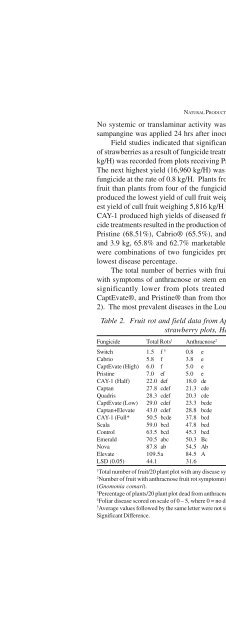Allelochemicals Biologica... - Name
Allelochemicals Biologica... - Name
Allelochemicals Biologica... - Name
You also want an ePaper? Increase the reach of your titles
YUMPU automatically turns print PDFs into web optimized ePapers that Google loves.
NATURAL PRODUCT BASED FUNGICIDES 11<br />
No systemic or translaminar activity was detected when azoxystrobin, CAY-1, or<br />
sampangine was applied 24 hrs after inoculation with C. fragariae (Pre, Table 1).<br />
Field studies indicated that significant differences occurred in marketable yield<br />
of strawberries as a result of fungicide treatments. The highest marketable yield (17,071<br />
kg/H) was recorded from plots receiving Pristine fungicide at the rate of 0.62 kg ai/H.<br />
The next highest yield (16,960 kg/H) was harvested from plants treated with Switch<br />
fungicide at the rate of 0.8 kg/H. Plants from the untreated control plots yielded more<br />
fruit than plants from four of the fungicide-treated plots. Plants treated with CAY-1<br />
produced the lowest yield of cull fruit weighing 1,390 kg/H. compared with the highest<br />
yield of cull fruit weighing 5,816 kg/H produced on the plots treated with Pristine.<br />
CAY-1 produced high yields of diseased fruit weighing over 9,400 kg/H. Five fungicide<br />
treatments resulted in the production of marketable fruit at 60%: Switch® (69.8%),<br />
Pristine (68.51%), Cabrio® (65.5%), and the two CaptEvate® treatments (5.8 kg.<br />
and 3.9 kg, 65.8% and 62.7% marketable fruit, respectively). Most treatments that<br />
were combinations of two fungicides produced the highest marketable yields and<br />
lowest disease percentage.<br />
The total number of berries with fruit rot symptoms and the number of berries<br />
with symptoms of anthracnose or stem end rot from the April 24 harvest time were<br />
significantly lower from plots treated with the fungicides Switch, Cabrio®,<br />
CaptEvate®, and Pristine® than from those receiving no fungicide treatment (Table<br />
2). The most prevalent diseases in the Louisiana field study were anthracnose caused<br />
Table 2. Fruit rot and field data from April 24, 2003 harvest of fungicide treated<br />
strawberry plots, Hammond, Louisiana.<br />
Fungicide Total Rots1 Anthracnose2 Stem end rot2 Plants Dead (%) 3 Foliar disease4 Switch 1.5 f 5 0.8 e 0.0 d 16.3 a 2.8 a<br />
Cabrio 5.8 f 3.8 e 0.5 d 8.8 cde 2.6 ab<br />
CaptEvate (High) 6.0 f 5.0 e 0.5 d 5.0 e 1.1 e<br />
Pristine 7.0 ef 5.0 e 0.3 d 5.0 e 2.5 abc<br />
CAY-1 (Half) 22.0 def 18.0 de 2.0 cd 15.6 ab 2.8 a<br />
Captan 27.8 cdef 21.3 cde 3.0 cd 7.5 cde 2.0 bcd<br />
Quadris 28.3 cdef 20.3 cde 2.8 cd 8.1 cde 1.9 cd<br />
CaptEvate (Low) 29.0 cdef 23.3 bcde 2.5 cd 7.5 cde 1.8 de<br />
Captan+Elevate 43.0 cdef 28.8 bcde 7.0 bcd 12.5 abc 2.0 bcd<br />
CAY-1 (Full* 50.5 bcde 37.8 bcd 7.5 bcd 10.6 abcde 3.1 a<br />
Scala 59.0 bcd 47.8 bcd 7.0 bcd 9.4 bcde 1.9 cd<br />
Control 63.5 bcd 45.3 bcd 9.8 abc 5.6 de 2.8 a<br />
Emerald 70.5 abc 50.3 Bc 7.8 abcd 5.6 de 2.9 a<br />
Nova 87.8 ab 54.5 Ab 16.0 a 7.5 cde 2.0 bcd<br />
Elevate 109.5a 84.5 A 14.3 ab 11.9 abcd 2.6 ab<br />
LSD (0.05) 44.1 31.6 8.4 6.8 0.7<br />
1Total number of fruit/20 plant plot with any disease symptom.<br />
2Number of fruit with anthracnose fruit rot symptomn (Colletotrichum acutatum) or Stem-End Rot<br />
(Gnomonia comari).<br />
3Percentage of plants/20 plant plot dead from anthracnose crown rot.<br />
4Foliar disease scored on scale of 0 – 5, where 0 = no disease and 5 = plant defoliated due to foliar disease.<br />
5Average values followed by the same letter were not significantly different at the 0.05 level using a Least<br />
Significant Difference.


